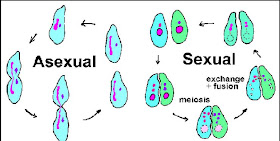Pages
▼
Reproduction
Nuclear division is often coordinated with cell division. This generally takes place by mitosis, a process that allows each daughter nucleus to receive one copy of each chromosome. In most eukaryotes, there is also a process of sexual reproduction, typically involving an alternation between haploid generations, wherein only one copy of each chromosome is present, and diploid generations, wherein two are present, occurring through nuclear fusion (syngamy) and meiosis. There is considerable variation in this pattern, however.
Eukaryotes have a smaller surface area to volume ratio than prokaryotes, and thus have lower metabolic rates and longer generation times. In some multicellular organisms, cells specialized for metabolism will have enlarged surface areas, such as intestinal vili.

No comments:
Post a Comment